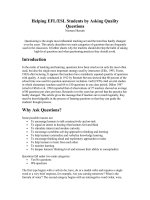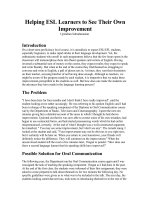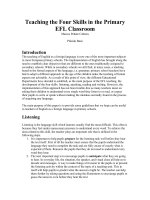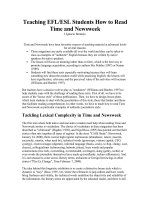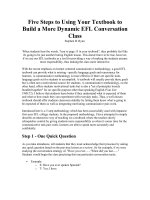Helping EFL
Bạn đang xem bản rút gọn của tài liệu. Xem và tải ngay bản đầy đủ của tài liệu tại đây (70.22 KB, 4 trang )
Helping EFL/ESL Students by Asking Quality
Questions
Nasreen Hussain
Questioning is the single most influential teaching act and the trend has hardly changed
over the years. This article describes two main categories of questions that are frequently
used in the classroom. It further shares why the teachers should develop the habit of asking
high-level questions and what questioning practices they should avoid.
Introduction
In the realm of teaching and learning, questions have been cited as not only the most often
used, but also the single most important strategy used by instructors (Ellis, 1993, Foster,
1983) after lecturing. It appears that teachers have mistakenly equated quantity of questions
with quality. A study conducted in 1912 by Romiett Stevens showed that 80 percent of the
school time was used for question-and-answer recitation. Gall (1970) cited several studies
in which elementary teachers used 64 to 180 questions in one class period. Dillon 1987
(cited in Orlich et al. 1994) reported that of observations of 27 teachers showed an average
of 80 questions per class per hour. Research over the years has proved that the practice has
hardly changed. This article gives the message that if teachers are to teach logically, they
must be knowledgeable in the process of framing questions so that they can guide the
students' thought process.
Why Ask Questions?
Some possible reasons are:
• To encourage learners to talk constructively and on-task
• To signal an interst in hearing what learners feel and think
• To stimulate interest and awaken curiosity
• To encourage a problem-solving approach to thinking and learning
• To help learners externalize and verbalize knowledge learning
• To encourage thinking aloud and exploratory approaches to tasks
• To help learners to learn from each other
• To monitor learning
• To deepen learners' thinking level and increase their ability to conceptualize
Questions fall under two main categories:
• Yes/No questions
• Wh-questions
The first type begins with a verb (to be, have, do or a modal verb) and requires a single
word or a very brief response, for example, Are you coming tomorrow? What is the
formula of water? The second category begins with an interrogative word (what, were,
why, when, how). They are also known as information questions, because they ask the
responder to provide particulars (Woodbury, 1984).
There are a number of ways of categorizing wh-question type. A simple method is as
follows:
1. a data recall question
Requires the learner to remember facts, information without putting the information
to use, for example, 'What are the four rules of number?'
2. a naming question
Asks the learner simply to name an event, process, phenomenon etc. without
showing insight into how the event is linked to other factors, for example, 'What do
we call the set of bones which cover the lungs?'
3. an observation question
Asks learners to describe what they see without attempting to explain it, for
example, 'What happened when we added salt to boiling water?'
4. a control question
Involves the use of questions to modify learners' behaviour rather than their
learning, for example, 'Will you sit down, Kashif?
5. a pseudo-question
Is constructed to appear that the teacher will accept more than one response, but in
fact he/she has clearly made up his / her mind that this is not so, for example, 'Do
you feel involving in violence was a good thing, then?'
6. a speculative or hypothesis generating question
Asks learners to speculate about the outcome of a hypothetical situation, for
example, 'Imagine a world without trees, how would this affect our lives?'
7. a reason or analysis question
Ask learners to give reason (s) why certain things do or do not happen, for example,
'What motivates some young people to get involved in drug abuse?
8. an evaluation question
Is one that makes a learner weigh out the pros and cons of a situation or argument,
for example, 'How much evidence is there for the existence of an after-life?'
9. a problem solving question
Asks learners to construct ways of finding out answers to questions, for example,
'Suppose we wanted to discover what prompts birds to migrate, how could we go
about it?'
NB: Question types 1-5 are more 'closed' than types 6-9. Types 1-5 demand shorter
answers, less thought and little competence in language use by the learners. Types 6-9 are
more demanding.
Questioning Procedure
It is generally a poor method of questioning when the instructor asks questions and allows
the entire group to answer in chorus. This method could stimulate a dull class or encourage
learners to participate; however it also has some disadvantages. Choral answers permit the
learners' attention to wander, decrease individual thought, and restrict the teachers to
monitor feedback from the class.
Mental participation of the learners can be achieved through the simple five part
questioning procedure explained below. This rule is based on the psychological principle
that when a question is asked and then followed by a pause, all learners will attend to the
communication. The nonverbal message (pause) communicates that any learner in the class
could be called to for a response. Thus, the attention level of the learner remains high. The
technique of framing thus entails:
1. Ask the question.
The teachers should state the question clearly and concisely. If a question is
complicated, it may be necessary to rephrase it. It is imperative that the question is
stated first before naming the learner to respond.
2. Pause.
After asking a question, pausing is important so that everyone has time to think.
Waiting time is essential when asking high-level question.
3. Call on the learner by name.
Learners should be randomly selected to answer the questions so that they try to
formulate the answer.
4. Listen to the answer.
A good technique that teachers can use to ensure that the learners are attentive is to
ask another learner to respond to the answer given.
5. Emphasize the correct answer.
The teachers could ask probing questions to have the respondents' response
clarified, to support a point, or to extend their thinking.
Characteristics of Good Questions
The learners should be able to understand the questions asked and the meaning of the
questions should be clear to them.
• Questions asked must be according to the level of the learners.
• Questions with definite answers should be encouraged.
• Challenging questions that require learners to compare, evaluate, or draw inference
should be asked.
• A question should not have a 'trick' or 'catch' to it.
• Yes/No questions should be avoided.
Practices to be Avoided
• Repeating ones own questions
• Repeating learners' answers
• Answering ones own questions
• Questioning for chorus answering
• Not allowing learners to complete a long response
• Not attending to the responding learner
• Selecting the same learner respondents
Conclusion
Research over the last sixty years has shown that, of teachers' questions, the predominating
ones are those that are concerned with simple data and recall of facts already learned which
fall under lower order questions. Several reasons for asking such questions have been
proposed. Firstly, teachers feel that learners should learn to focus on facts that they must
use when answering more interpretative questions later on. The second apparent reason is
that teachers are not trained in the use of questioning strategies, and lastly teachers do not
use a system to organize and classify questions. It is, therefore, imperative that teachers
should inculcate the habit of asking more thought provoking questions so that learners'
involvement in the process of learning increases. Another important consideration is that
the teachers should make sure that the teaching materials provide an opportunity to ask
focused questions that require learners to compare, contrast, persuade, and determine cause
and effect, which would develop their process of thinking.
All teachers must become aware of the kinds of questions they ask and the kinds of
responses that these questions elicit. If the teachers desire a response at a selected level of
thinking, then appropriate questions must be framed that will elicit proper response level
from the students. Although evidence is somewhat inconclusive, there appears to be a
direct relationship between the level of questions asked by the teachers and the level of
learners' responses. If this generally accepted assertion is valid, then teachers must achieve
a high degree of sensitivity and awareness to use questions in the most efficacious and
appropriate manner, "so that their learners may develop higher levels of thinking to
evaluate information, to achieve more, and to be more interested" (Orlich, Harder,
Callahan, Kauchak, & Gibson 1994, p. 185). Rather than emphasizing a right answer,
teachers should use questions to stimulate higher cognitive achievements and to make
information more meaningful. To conclude, good questions and good questioning
techniques can make a fair teacher good and a good teacher great.



